
INTERVIEW
Who is U-ku, an up-and-coming young contemporary artist?
Follow TRiCERA on Instagram and check out our creative artists
5%OFF & free shipping 1st purchase
FIRSTART5
10%OFF 2nd purchase after 1st purchase!
Welcome to TRiCERA
Hi there! We are pleased to have you here 🎉
Could you please describe yourself?
Guest
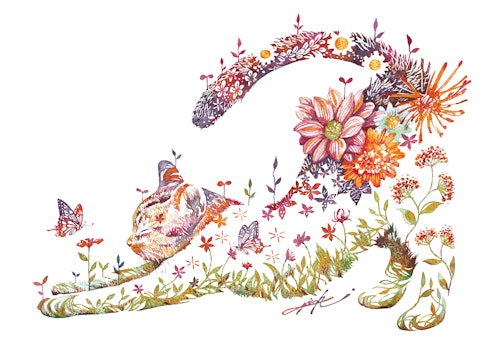
Colorful and vivid colors and animals that seem to be born from flowers, plants, and trees.
The works of Hiroki Takeda, a watercolorist, attract the viewer's eye at once with their exquisite gradation, which is only possible with transparent watercolor, and their unique drawing style that makes the most of margins.
To trace the source of his creativity, TRiCERA ART staff member Okumura conducted an interview with the artist.
What kind of person is Hiroki Takeda, who is busy creating art as TRiCERA's first resident artist?
What was the initial impetus for you to start drawing?
I have loved manga since I was a child, and I often copied manga pictures.
That was when I first became interested in drawing.
I especially liked "Dragon Ball. It was the only manga I watched. In the latter half of elementary school, I also liked "Slam Dunk.
I used to color in all the pages of Dragon Ball comics.
Manga is drawn with black-and-white lines, so I thought the whole thing was a coloring book. Now that I think about it, it seems like such a waste (laughs).
When I entered junior high school, it became harder and harder to study. That is probably why I became more absorbed in painting.
I didn't want to do ordinary studies anymore. So I entered Niiza Sogo Gijutsu High School, which had a design department, where I took specialized classes such as drawing.
My high school teacher was quite impressed with my work and encouraged me to go to art school.
So I naturally decided to go to art school.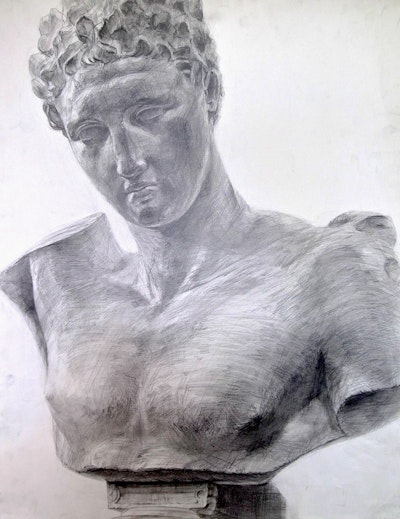
Plaster sketches in high school
That was how it went, so when I entered university, I was like, "I'm going to be a designer.
I had a job in sight, and I thought that if I liked drawing and wanted to make it my career, design would be the way to go.
I entered Nagoya Zokei University and majored in graphic design.
The first year at the university I did basic work. Instead of suddenly designing on a computer, we worked with sketches and paints.
There was a class using transparent watercolor, and it was there that I encountered the work of Mr. Goro Sasaki.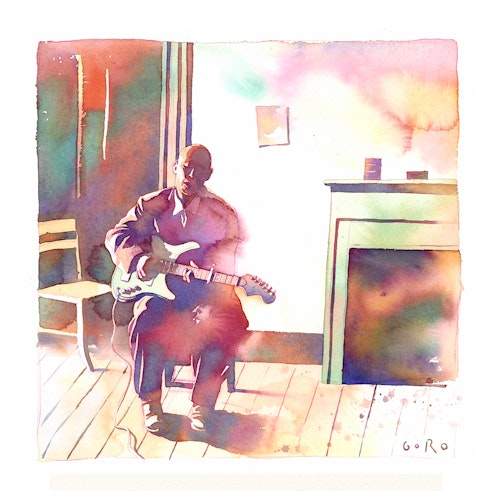
Goro Sasaki's official websitefrom Goro Sasaki's official website
Mr. Sasaki came to the university once a week to teach watercolor, and I was really shocked by his expression.
Until then, I had the impression that "watercolor" was a fluffy painting medium used by elderly people as a hobby, but the contrast in Mr. Sasaki's work was strong.
The contrast in Mr. Sasaki's work was strong, and the use of color was something I had never seen before. I genuinely thought his work was "cool.
I had been drawing pop and cute pictures until then, but from that moment on, I started to shift to mature and cool pictures using "blotting" and other techniques.
At the same time, I realized during my four years at university that design was not for me. I also realized that analog was more suited to my nature than digital.
So, after I decided that I was not a designer, I first aimed to become an illustrator.
I had studied design and thought a job as an illustrator would be close.
After graduating from college in 2010, I worked as an illustrator while working part-time. It was a time when I was still exploring and searching for my own pictures. I experimented with a variety of art materials.
For about a year to a year and a half, I was experimenting with various painting materials, but my love for the beautiful colors of watercolor was growing. In the end, I came back to watercolor as an art medium.
At first, I was good at painting people's faces, but after realizing the appeal of watercolor, I began to actively try painting other things besides people's faces.
Around that time, the image of "painting animals with flowers" gradually came to me.
I think my current style has been solidified since about 2012.
Hiroki Takeda, "Tiger," 2020, W 38.30cm x H 53.50cm
During your exploratory period, you experimented with a variety of painting materials.
No, I did not do much oil painting.
Someone has been doing oil paintings and Japanese-style paintings for decades or centuries. I was thinking very much about "what only I can do," and I was doing very experimental things, for example, tearing paintings, pasting something on top, splattering paint, and eventually burning burnt paintings to make them into pictures.
I was thinking that I was the only one doing this, but at the same time I wondered how I would get work with this kind of work.
On the other hand, there were times when I looked at the works of other active artists and wondered how they were able to draw such amazing things, and at other times I was at a loss for words.
However, I was working as an illustrator anyway, and when I thought of my work as having a deadline, I did not go that way because oil paintings dry slowly.
When we hear that you were burning paintings, we can't imagine that you were also making things that we can't imagine from your current works.
You mentioned Goro Sasaki's name, but what kind of person influenced Mr. Takeda's current style?
Goro Sasaki's paintings have a certain individuality, as if to say, "This is already a blotch of Goro Sasaki.
While I admired him, I always had the feeling that I could produce something different from him, "Hiroki Takeda's colors," even if I used the same transparent watercolor. I would never go down the same path.
I also got to know the artist "OHGUSHI " when I was in college, and I liked his works very much, and he later became a great help to me.
OHGUSHI "Cloud and Dragon" by Myokyoji Temple, Mogami Inariyama|Double winner of the Silver and Bronze awards at the ADC 102nd Annual Awards, 2023.
He mainly used ink to draw women's faces in bold compositions and styles.
In 2012, when I was just starting to develop my own style, I was confident in this watercolor style, but the response from people I knew was not good.
I wanted to know what professionals thought of my work from a more objective point of view, so I was doing research when I came across a project called "Terakoya" organized by Mr. OHGUSHI.
(Terakoya: A non-profit activity organized by OHGUSHI, an ink and watercolor artist, in which instructors, mainly professional illustrators, provide students with opportunities to receive specific advice. 12 years of history will end in 2022, but another project is planned to be launched. Terakoya official website)
So I was able to give a presentation in front of people who are actually active in the field, such as a person who works at Dentsu and the president of a design magazine. It was just the first "Terakoya" event.
When I presented my work there, it was quite well received.
The president of "Illustration Note" magazine gave me a push and said, "Your work is really beautiful, so keep going with it.
The recognition I received at that time gave me confidence and assurance that I could go on with my work.
After that, Mr. OHGUSHI invited me several times to events he hosted, and I really learned a lot from him.
Mr. OHGSUHI is an illustrator as well as an artist who sells original paintings, and I am very much influenced by his way of working. He is truly my mentor.
After a period of seeking and working as an illustrator, you have now led to your current career as an artist.
At first, I tried to work as an illustrator, but the bottleneck was that I had to express myself exactly as the client wanted. It didn't go well and I couldn't meet deadlines.
So I thought it would be more enjoyable and more suited to me if I painted what I liked as much as I could. That is why I decided to become a painter.
Before I met Mr. Iguchi, I had no idea what I was doing. I had no idea how to sell my paintings as a painter, and I thought that the only way was to exhibit them.
I thought it would be important to first let as many people as possible know about my work by handing out postcards and business cards at events, and also because in this day and age there are social networking services and various events.
(Yasushi Iguchi: Representative of TRiCERA Inc. After working for a long-established audio equipment manufacturer and Germany's largest medical equipment manufacturer, he joined Nike. After working on several global projects in the area of supply chain and international logistics, he established TRiCERA Corporation in 2018. Ltd. in 2018, which is now one of the largest art marketplaces in Asia with more than 7,500 artists from over 126 countries and handling approximately 70,000 works of art).
Were there any deciding factors in meeting the representative, Iguchi, and working with TRiCERA?
I was approached by Mr. Iguchi at exactly the right time when I was switching my focus to working as a painter. The timing was really good.
At that time in particular, I was still aware that paintings could be sold overseas. However, it would cost hundreds of thousands of dollars to actually take a painting overseas. Even a small painting would cost that much, and if it did not sell, I would lose a lot of money.
When I was struggling with this situation, I attended the Design Festa held at Tokyo Big Sight and was approached by Mr. Iguchi.
He said, "We are going to start a company called TRiCERA, and would you like to sell your original artwork overseas as well? The key words "selling original artwork" were enough to make me say, "Yes, I would like to do that" (laughs).
(Laughs) He knew that it would cost a lot of money to do it normally, and his vision of "creating a platform for artists from all over the world" matched what I wanted to do.
However, at first, I was worried about whether I could really achieve such an ideal because I was too much of an artist first.
The dilemma that Mr. Takeda had and what TRiCERA was trying to solve matched exactly.
Since the Corona disaster, the art industry has moved online in many aspects. In this context, what does a gallery like TRiCERA, which has both online and offline operations, mean to artists?
When we first spoke with you, we were not originally thinking of domestic sales. We were going in the direction of connecting with overseas.
Even before I met TRiCERA, I had received various messages from overseas through direct messages on SNS. However, they were all written in English, and since I myself could not speak English, I had no choice but to ignore them at the time. I could deal with simple comments, but when I received long messages as job offers, it was very difficult... I had no choice but to ignore them. I had to let it slide.
But since I started working with TRiCERA, they have taken care of all these aspects. In fact, direct messages and e-mails have led to collaborations with overseas companies, and when there have been problems, we have been able to resolve them in light of the laws of both countries, which really helped us in areas that require specialized knowledge and skills.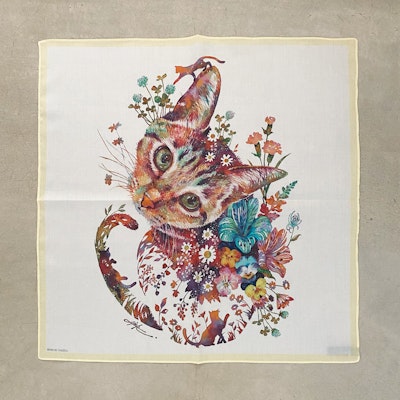
Collaboration work with bluespot Inc. Large-sized bandana handkerchiefs reproducing works of art with a precise touch.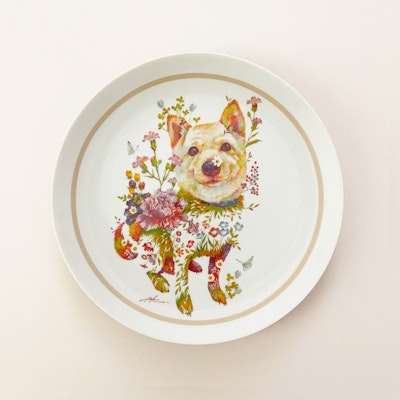
A collaborative work with bluespot Co. Premium plates carefully crafted one by one at a Kutani pottery kiln.
In the process of "becoming able to eat as an artist," if I have to handle such inquiries and other correspondence by myself when I start to gain popularity, I have less time to do my original job as an artist, "painting," anyway. I was having a lot of trouble with this aspect of the process when I met TRiCERA, which helped me not only with the language problem mentioned above, but also with various other issues such as communication and planning on my behalf. That is the most important thing.
Do you have any expectations for TRiCERA in the future?
Currently, TRiCERA often asks us to come up with various projects, and there are always challenges.
I would like to see TRiCERA become more of a platform after the challenges in front of us have been successfully stabilized.
If we eventually develop into a merchandise business, I think it would not be good if the original artwork is placed together with the merchandise, so I would appreciate it if you could separate the pages or create a dedicated page for them.
I think you are currently preparing for your solo exhibition in July 2023. May I ask what the theme of your work will be?
I am working on the theme of "divine beasts" for this solo exhibition.
Up until now, I have painted dogs, cats, and other creatures that actually exist, but I was motivated to develop from that and paint creatures as gods that do not actually exist on a larger-than-usual screen.
I am still researching and creating them myself, but each of the several gods and beasts has its own theme color, so to speak.
I used to draw real creatures as colorfully as I wanted, but for each of the sacred beasts, I focused on a specific color. For example, for "Suzaku," I used the image of red. I have never taken the approach of narrowing down the colors, so this is one of the challenges for me.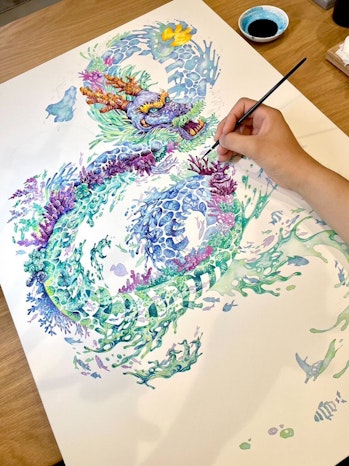
New work in progress for the next solo exhibition
As you become a more popular artist, you are receiving more commissions and other orders for your work. Apart from that, do you have any plans for what you would like to do after your solo exhibition in July?
I will continue to use watercolor as my main medium.
As for the theme, I have been painting animals a lot lately, so I would like to paint non-animal subjects as well.
As I paint day by day, I take notes of things I suddenly think of that I would like to paint.
I would also like to take the time to create larger works. Even if it has nothing to do with the exhibition.
However, while taking on such challenges, I do not want to do something completely different, and I would like to create works that are recognizable as "Hiroki Takeda" works at a glance. I would like to do this by updating the content of the expression.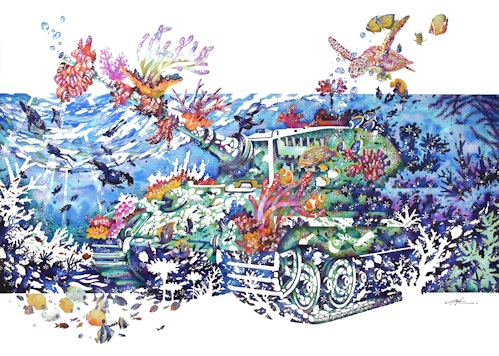
I would also like to create works that are not his best-known animal paintings. Hiroki Takeda, "Life in Bloom," 2022, W 103.00cm x H 72.80cm
This is the last question. As an artist, do you have any goals or targets that you envision for the future?
I often live-stream my work on Instagram, and there is one thing I often talk about.
There is a TV program that asks people from overseas, "What do you know about Japan?" The people who don't know about Japan are often asked questions like, "Japan? If you don't know Japan, you might say, "Japan? Where in China was it?" The person who doesn't know about Japan would answer, "Japan?
The interviewee would reply, "Japan?
Japan? As I recall, Hiroki Takeda is Japanese, right? I have never been to Japan, but I know a lot about Hiroki Takeda.
I would like to be a person who is well known in Japan.
In any case, I would like to keep increasing the number of people who know of my existence.
That is a very specific and wonderful goal! Thank you very much for taking part in today's interview.
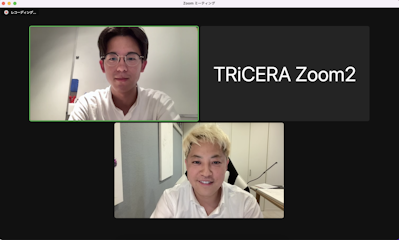
Interview: May 19, 2023, online. Mr. Hiroki Takeda is at the bottom of the screen
View Hiroki Takeda's artist page
TRiCERA ART members receive a variety of benefits and preferences.
- Discounts such as members-only secret sales and coupons
- Create My Collection by registering your favorite artists
- Receive updates on popular artists, exhibitions, and events
- Receive a weekly newsletter with selected art
- Personal Assessment to find out what kind of art you like.
Please register as a member for free and receive the latest information.

Writer
TRiCERA ART

Colorful and vivid colors and animals that seem to be born from flowers, plants, and trees.
The works of Hiroki Takeda, a watercolorist, attract the viewer's eye at once with their exquisite gradation, which is only possible with transparent watercolor, and their unique drawing style that makes the most of margins.
To trace the source of his creativity, TRiCERA ART staff member Okumura conducted an interview with the artist.
What kind of person is Hiroki Takeda, who is busy creating art as TRiCERA's first resident artist?
What was the initial impetus for you to start drawing?
I have loved manga since I was a child, and I often copied manga pictures.
That was when I first became interested in drawing.
I especially liked "Dragon Ball. It was the only manga I watched. In the latter half of elementary school, I also liked "Slam Dunk.
I used to color in all the pages of Dragon Ball comics.
Manga is drawn with black-and-white lines, so I thought the whole thing was a coloring book. Now that I think about it, it seems like such a waste (laughs).
When I entered junior high school, it became harder and harder to study. That is probably why I became more absorbed in painting.
I didn't want to do ordinary studies anymore. So I entered Niiza Sogo Gijutsu High School, which had a design department, where I took specialized classes such as drawing.
My high school teacher was quite impressed with my work and encouraged me to go to art school.
So I naturally decided to go to art school.
Plaster sketches in high school
That was how it went, so when I entered university, I was like, "I'm going to be a designer.
I had a job in sight, and I thought that if I liked drawing and wanted to make it my career, design would be the way to go.
I entered Nagoya Zokei University and majored in graphic design.
The first year at the university I did basic work. Instead of suddenly designing on a computer, we worked with sketches and paints.
There was a class using transparent watercolor, and it was there that I encountered the work of Mr. Goro Sasaki.
Goro Sasaki's official websitefrom Goro Sasaki's official website
Mr. Sasaki came to the university once a week to teach watercolor, and I was really shocked by his expression.
Until then, I had the impression that "watercolor" was a fluffy painting medium used by elderly people as a hobby, but the contrast in Mr. Sasaki's work was strong.
The contrast in Mr. Sasaki's work was strong, and the use of color was something I had never seen before. I genuinely thought his work was "cool.
I had been drawing pop and cute pictures until then, but from that moment on, I started to shift to mature and cool pictures using "blotting" and other techniques.
At the same time, I realized during my four years at university that design was not for me. I also realized that analog was more suited to my nature than digital.
So, after I decided that I was not a designer, I first aimed to become an illustrator.
I had studied design and thought a job as an illustrator would be close.
After graduating from college in 2010, I worked as an illustrator while working part-time. It was a time when I was still exploring and searching for my own pictures. I experimented with a variety of art materials.
For about a year to a year and a half, I was experimenting with various painting materials, but my love for the beautiful colors of watercolor was growing. In the end, I came back to watercolor as an art medium.
At first, I was good at painting people's faces, but after realizing the appeal of watercolor, I began to actively try painting other things besides people's faces.
Around that time, the image of "painting animals with flowers" gradually came to me.
I think my current style has been solidified since about 2012.
Hiroki Takeda, "Tiger," 2020, W 38.30cm x H 53.50cm
During your exploratory period, you experimented with a variety of painting materials.
No, I did not do much oil painting.
Someone has been doing oil paintings and Japanese-style paintings for decades or centuries. I was thinking very much about "what only I can do," and I was doing very experimental things, for example, tearing paintings, pasting something on top, splattering paint, and eventually burning burnt paintings to make them into pictures.
I was thinking that I was the only one doing this, but at the same time I wondered how I would get work with this kind of work.
On the other hand, there were times when I looked at the works of other active artists and wondered how they were able to draw such amazing things, and at other times I was at a loss for words.
However, I was working as an illustrator anyway, and when I thought of my work as having a deadline, I did not go that way because oil paintings dry slowly.
When we hear that you were burning paintings, we can't imagine that you were also making things that we can't imagine from your current works.
You mentioned Goro Sasaki's name, but what kind of person influenced Mr. Takeda's current style?
Goro Sasaki's paintings have a certain individuality, as if to say, "This is already a blotch of Goro Sasaki.
While I admired him, I always had the feeling that I could produce something different from him, "Hiroki Takeda's colors," even if I used the same transparent watercolor. I would never go down the same path.
I also got to know the artist "OHGUSHI " when I was in college, and I liked his works very much, and he later became a great help to me.
OHGUSHI "Cloud and Dragon" by Myokyoji Temple, Mogami Inariyama|Double winner of the Silver and Bronze awards at the ADC 102nd Annual Awards, 2023.
He mainly used ink to draw women's faces in bold compositions and styles.
In 2012, when I was just starting to develop my own style, I was confident in this watercolor style, but the response from people I knew was not good.
I wanted to know what professionals thought of my work from a more objective point of view, so I was doing research when I came across a project called "Terakoya" organized by Mr. OHGUSHI.
(Terakoya: A non-profit activity organized by OHGUSHI, an ink and watercolor artist, in which instructors, mainly professional illustrators, provide students with opportunities to receive specific advice. 12 years of history will end in 2022, but another project is planned to be launched. Terakoya official website)
So I was able to give a presentation in front of people who are actually active in the field, such as a person who works at Dentsu and the president of a design magazine. It was just the first "Terakoya" event.
When I presented my work there, it was quite well received.
The president of "Illustration Note" magazine gave me a push and said, "Your work is really beautiful, so keep going with it.
The recognition I received at that time gave me confidence and assurance that I could go on with my work.
After that, Mr. OHGUSHI invited me several times to events he hosted, and I really learned a lot from him.
Mr. OHGSUHI is an illustrator as well as an artist who sells original paintings, and I am very much influenced by his way of working. He is truly my mentor.
After a period of seeking and working as an illustrator, you have now led to your current career as an artist.
At first, I tried to work as an illustrator, but the bottleneck was that I had to express myself exactly as the client wanted. It didn't go well and I couldn't meet deadlines.
So I thought it would be more enjoyable and more suited to me if I painted what I liked as much as I could. That is why I decided to become a painter.
Before I met Mr. Iguchi, I had no idea what I was doing. I had no idea how to sell my paintings as a painter, and I thought that the only way was to exhibit them.
I thought it would be important to first let as many people as possible know about my work by handing out postcards and business cards at events, and also because in this day and age there are social networking services and various events.
(Yasushi Iguchi: Representative of TRiCERA Inc. After working for a long-established audio equipment manufacturer and Germany's largest medical equipment manufacturer, he joined Nike. After working on several global projects in the area of supply chain and international logistics, he established TRiCERA Corporation in 2018. Ltd. in 2018, which is now one of the largest art marketplaces in Asia with more than 7,500 artists from over 126 countries and handling approximately 70,000 works of art).
Were there any deciding factors in meeting the representative, Iguchi, and working with TRiCERA?
I was approached by Mr. Iguchi at exactly the right time when I was switching my focus to working as a painter. The timing was really good.
At that time in particular, I was still aware that paintings could be sold overseas. However, it would cost hundreds of thousands of dollars to actually take a painting overseas. Even a small painting would cost that much, and if it did not sell, I would lose a lot of money.
When I was struggling with this situation, I attended the Design Festa held at Tokyo Big Sight and was approached by Mr. Iguchi.
He said, "We are going to start a company called TRiCERA, and would you like to sell your original artwork overseas as well? The key words "selling original artwork" were enough to make me say, "Yes, I would like to do that" (laughs).
(Laughs) He knew that it would cost a lot of money to do it normally, and his vision of "creating a platform for artists from all over the world" matched what I wanted to do.
However, at first, I was worried about whether I could really achieve such an ideal because I was too much of an artist first.
The dilemma that Mr. Takeda had and what TRiCERA was trying to solve matched exactly.
Since the Corona disaster, the art industry has moved online in many aspects. In this context, what does a gallery like TRiCERA, which has both online and offline operations, mean to artists?
When we first spoke with you, we were not originally thinking of domestic sales. We were going in the direction of connecting with overseas.
Even before I met TRiCERA, I had received various messages from overseas through direct messages on SNS. However, they were all written in English, and since I myself could not speak English, I had no choice but to ignore them at the time. I could deal with simple comments, but when I received long messages as job offers, it was very difficult... I had no choice but to ignore them. I had to let it slide.
But since I started working with TRiCERA, they have taken care of all these aspects. In fact, direct messages and e-mails have led to collaborations with overseas companies, and when there have been problems, we have been able to resolve them in light of the laws of both countries, which really helped us in areas that require specialized knowledge and skills.
Collaboration work with bluespot Inc. Large-sized bandana handkerchiefs reproducing works of art with a precise touch.
A collaborative work with bluespot Co. Premium plates carefully crafted one by one at a Kutani pottery kiln.
In the process of "becoming able to eat as an artist," if I have to handle such inquiries and other correspondence by myself when I start to gain popularity, I have less time to do my original job as an artist, "painting," anyway. I was having a lot of trouble with this aspect of the process when I met TRiCERA, which helped me not only with the language problem mentioned above, but also with various other issues such as communication and planning on my behalf. That is the most important thing.
Do you have any expectations for TRiCERA in the future?
Currently, TRiCERA often asks us to come up with various projects, and there are always challenges.
I would like to see TRiCERA become more of a platform after the challenges in front of us have been successfully stabilized.
If we eventually develop into a merchandise business, I think it would not be good if the original artwork is placed together with the merchandise, so I would appreciate it if you could separate the pages or create a dedicated page for them.
I think you are currently preparing for your solo exhibition in July 2023. May I ask what the theme of your work will be?
I am working on the theme of "divine beasts" for this solo exhibition.
Up until now, I have painted dogs, cats, and other creatures that actually exist, but I was motivated to develop from that and paint creatures as gods that do not actually exist on a larger-than-usual screen.
I am still researching and creating them myself, but each of the several gods and beasts has its own theme color, so to speak.
I used to draw real creatures as colorfully as I wanted, but for each of the sacred beasts, I focused on a specific color. For example, for "Suzaku," I used the image of red. I have never taken the approach of narrowing down the colors, so this is one of the challenges for me.
New work in progress for the next solo exhibition
As you become a more popular artist, you are receiving more commissions and other orders for your work. Apart from that, do you have any plans for what you would like to do after your solo exhibition in July?
I will continue to use watercolor as my main medium.
As for the theme, I have been painting animals a lot lately, so I would like to paint non-animal subjects as well.
As I paint day by day, I take notes of things I suddenly think of that I would like to paint.
I would also like to take the time to create larger works. Even if it has nothing to do with the exhibition.
However, while taking on such challenges, I do not want to do something completely different, and I would like to create works that are recognizable as "Hiroki Takeda" works at a glance. I would like to do this by updating the content of the expression.
I would also like to create works that are not his best-known animal paintings. Hiroki Takeda, "Life in Bloom," 2022, W 103.00cm x H 72.80cm
This is the last question. As an artist, do you have any goals or targets that you envision for the future?
I often live-stream my work on Instagram, and there is one thing I often talk about.
There is a TV program that asks people from overseas, "What do you know about Japan?" The people who don't know about Japan are often asked questions like, "Japan? If you don't know Japan, you might say, "Japan? Where in China was it?" The person who doesn't know about Japan would answer, "Japan?
The interviewee would reply, "Japan?
Japan? As I recall, Hiroki Takeda is Japanese, right? I have never been to Japan, but I know a lot about Hiroki Takeda.
I would like to be a person who is well known in Japan.
In any case, I would like to keep increasing the number of people who know of my existence.
That is a very specific and wonderful goal! Thank you very much for taking part in today's interview.

Interview: May 19, 2023, online. Mr. Hiroki Takeda is at the bottom of the screen
View Hiroki Takeda's artist page
TRiCERA ART members receive a variety of benefits and preferences.
- Discounts such as members-only secret sales and coupons
- Create My Collection by registering your favorite artists
- Receive updates on popular artists, exhibitions, and events
- Receive a weekly newsletter with selected art
- Personal Assessment to find out what kind of art you like.
Please register as a member for free and receive the latest information.

Writer
TRiCERA ART